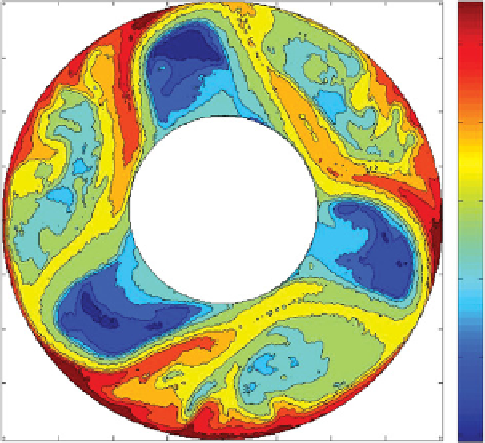Geoscience Reference
In-Depth Information
200
30
150
100
29.5
50
29
0
-50
28.5
-100
28
-150
-200
27.5
-200
-150
-100
-50 0
Experiment
50
100
150
200
DNS
Figure 16.10.
Instantaneous temperature field at the open upper free surface for the water-filled cavity. For color detail, please
see color plate section.
surface. The approach was applied to describe the various
spatiotemporal characteristics of baroclinic waves using
three different fluids. It has allowed for a detailed analysis
of the features observed during laboratory measurements.
The results demonstrate the ability of the present numer-
ical tool to reproduce the complex spatiotemporal behav-
iors and to capture the small-scale fluctuations responsible
for the break of the regular waves to chaotic motion in
baroclinic cavities. The simulations report the first realistic
solutions of weak waves and structural vacillation regimes
for liquids and amplitude vacillation for air, in agreement
with experimental observations. Moreover, the computa-
tions point out the important role played by the Prandtl
number on the baroclinic instability characteristics due
to the differences in the thermal stratification levels. In
particular, at high values of the Prandtl number, the spon-
taneous generation of IGWs was found simultaneously
with the large-scale baroclinic waves. These small-scale
features, initially developing along the inner cold cylin-
der, are postulated to be the mechanism responsible for
the transition to irregular flows.
The extension of the approach to parallel computing,
by implementing a domain decomposition technique, is in
progress and is expected to allow for a direct numerical
simulation of the fully developed turbulent flow regime in
the baroclinic cavity.
(LMD, Paris, France). The authors are indebted to
R. Wordsworth (AOPP, Oxford, UK), U. Harlander, and
C. Egbers (BTU, Cottbus, Germany) for their help in
providing experimental measurements. The authors are
grateful to the Spanish government for financial support,
research project number FIS2011-24642. This work
was granted access to the HPC resources NEC-SX8 of
CCRT (CEA, France) and NEC-SX5 of IDRIS (CNRS,
France) under the allocation 21444 made by GENCI
(Grand Equipement National de Calcul Intensif). The
authors are grateful to the anonymous referees for their
constructive criticisms and suggestions.
REFERENCES
Alexandrov, K., Y. Wang, U. Harlander, and C. Egbers, DFG-
MetStroem reference experiment, BTU, Cottbus, Germany.
Canuto, C., M. Hussaini, A. Quarteroni, and T. Zang (1987),
Spectral Methods in fluid Dynamics
, Springer-Verlag, Berlin.
Castrejón-Pita, A. A., and P. L. Read (2007), Baroclinic waves
in an air-filled thermally driven rotating annulus,
Phys. Rev.
E
,
75
, 026,301, doi:10.1103/PhysRevE.75.026301.
Chaouche, A. M., A. Randriamampianina, and P. Bontoux
(1990), A collocation method based on an influence matrix
technique for axisymmetric flows in an annulus,
Comp. Meth.
Appl. Mech. Eng.
,
80
, 237-244.
Fein, J. S., and R. L. Pfeffer (1976), An experimental study of the
effects of Prandtl number on thermal convection in a rotat-
ing, differentially heated cylindrical annulus of fluid,
J. Fluid
Mech.
,
75
, 81-112.
Fowlis, W. W., and R. Hide (1965), Thermal convection in a
rotating annulus of liquid: Effect of viscosity on the transition
Acknowledgments.
The authors would like to
acknowledge fruitful discussions with T. Jacoby and P. L.
Read (AOPP, Oxford, UK), W.-G. Früh (SEPS, Heriot-
Watt University, Edinburgh, UK), and R. Plougonven
































































